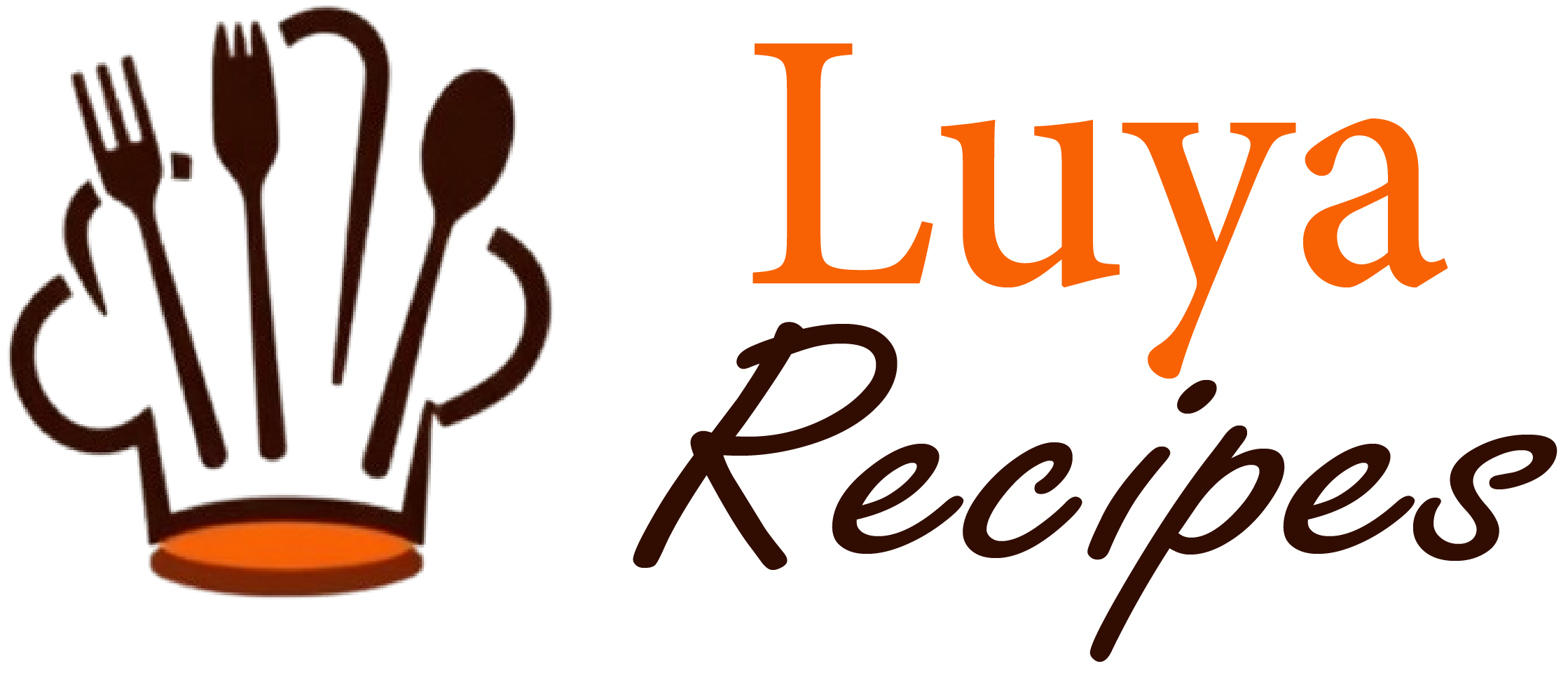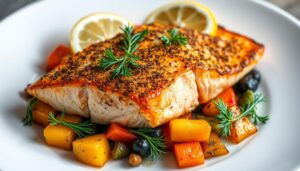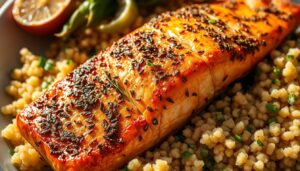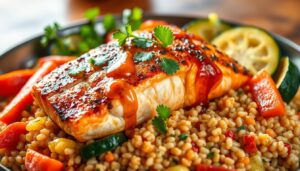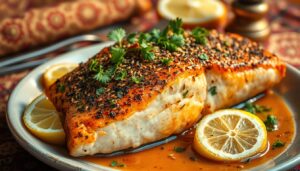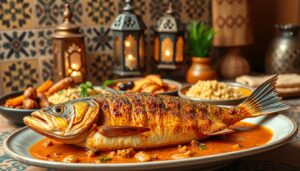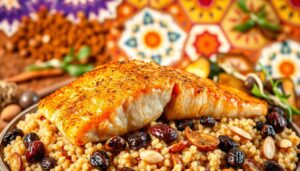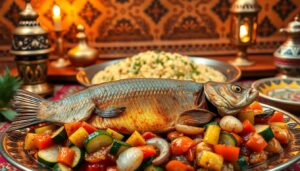Dive into the vibrant world of authentic Vietnamese cuisine with the tantalizing Vietnamese shaking beef, a dish that transforms simple ingredients into a culinary masterpiece. This extraordinary recipe brings the heart of Vietnam’s street food culture directly to your kitchen, offering a unique blend of flavors that will transport your taste buds.
At its core, Vietnamese shaking beef represents more than just a meal – it’s a celebration of traditional cooking techniques passed down through generations. The signature “shaking” method creates perfectly seared meat cubes that burst with rich, complex flavors unique to Vietnamese culinary traditions.
Key Takeaways
- Learn the authentic technique behind traditional Vietnamese shaking beef
- Discover the cultural significance of this iconic dish
- Master the art of marinating and cooking beef Vietnamese style
- Understand the importance of ingredient selection
- Explore the unique “shaking” cooking method
What Makes Vietnamese Shaking Beef a Culinary Masterpiece
Vietnamese beef recipes represent a remarkable journey through culinary history, with shaking beef (Bo Luc Lac) standing as a true gastronomic gem. This iconic dish embodies the rich flavors and intricate techniques of Vietnamese culinary tradition, captivating food lovers worldwide.
Origins of Bo Luc Lac
The story of Bo Luc Lac begins in the vibrant kitchens of Vietnam, where skilled chefs transformed simple ingredients into extraordinary meals. Originating in southern Vietnam, this dish emerged as a testament to the region’s culinary creativity. The name “Bo Luc Lac” literally translates to “shaking beef,” referencing the unique cooking technique that gives the dish its distinctive character.
Cultural Significance in Vietnamese Cuisine
In Vietnamese culinary tradition, Bo Luc Lac represents more than just a meal—it’s a cultural expression. Typically prepared for special occasions, this beef dish symbolizes hospitality and connection. Families gather around the table, sharing stories while enjoying the tender, flavorful meat that has been carefully prepared using generations-old techniques.
Traditional Preparation Methods
“Cooking is about passion, and Vietnamese beef recipes are a passionate art form.” – Chef Mai Pham
Traditional preparation of Bo Luc Lac involves carefully selecting high-quality beef, marinating it with a blend of garlic, soy sauce, and other secret ingredients, and then quickly searing the meat in a hot wok. The “shaking” technique ensures each piece is evenly cooked, creating a perfect balance of crispy exterior and tender interior.
Essential Ingredients for Perfect Vietnamese Beef
Creating an authentic vietnamese marinated beef dish starts with selecting the right ingredients. Your culinary journey begins with choosing high-quality beef cuts that can absorb rich flavors and develop a tender texture.
Lemongrass beef requires specific aromatics that transform an ordinary meal into an extraordinary experience. Fresh lemongrass stalks are crucial, providing a citrusy and slightly floral essence that defines traditional Vietnamese cooking. You’ll want to select firm, fragrant stalks with a pale green to white base.
“The magic of vietnamese marinated beef lies in its carefully selected ingredients” – Vietnamese Culinary Experts
Key ingredients for your lemongrass beef include:
- Premium beef sirloin or tenderloin
- Fresh lemongrass
- Garlic
- Soy sauce
- Fish sauce
- Dark caramel sauce
Each ingredient plays a critical role in developing the complex flavor profile that makes vietnamese marinated beef so distinctive. By understanding and respecting these components, you’ll create a dish that truly honors traditional Vietnamese cuisine.
Mastering the Art of Marination
When preparing Vietnamese beef recipes, marination is the secret weapon that transforms ordinary meat into an extraordinary culinary experience. The right technique can elevate your beef with garlic sauce from good to unforgettable.
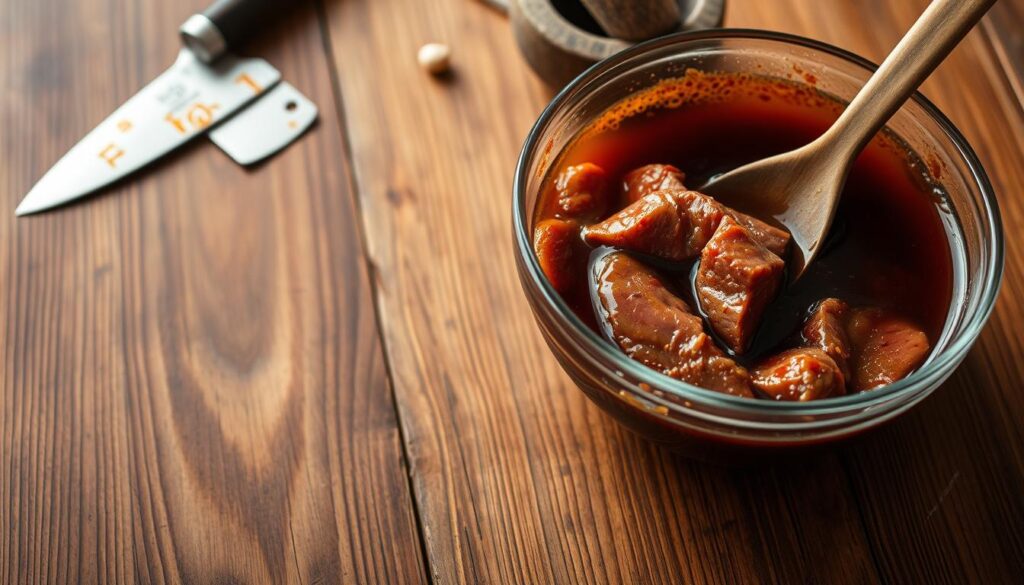
Marinating is more than just soaking meat. It’s an art form that requires precision, understanding, and patience. The process allows flavors to penetrate deep into the beef, creating a rich and complex taste profile that defines authentic Vietnamese cuisine.
Traditional Marinade Components
Your marinade should balance sweet, salty, and umami flavors. Key ingredients typically include soy sauce, fish sauce, garlic, sugar, and black pepper. These components work together to tenderize the meat and infuse it with traditional Vietnamese flavors.
Optimal Marination Time
Timing is crucial in Vietnamese beef recipes. For shaking beef, aim to marinate between 30 minutes to 2 hours. Shorter times preserve the meat’s natural texture, while longer marination can lead to over-tenderizing and loss of beef’s original character.
Secret Flavor Enhancers
“The difference between good and great beef lies in the subtle details of marination.” – Chef Mai Nguyen
Professional chefs recommend adding a splash of rice wine or a touch of sesame oil to your beef with garlic sauce. These unexpected ingredients can elevate your dish from home cooking to restaurant-quality cuisine.
The Perfect Cut: Choosing Your Beef
Selecting the right beef cut can make or break your vietnamese beef recipes. When preparing asian beef dishes like shaking beef, the meat’s quality determines the final taste and texture of your meal.
For authentic Vietnamese shaking beef, top sirloin stands out as the premier choice. This cut offers the perfect balance of lean meat and marbling that creates a tender, flavorful dish. Look for beef with fine white fat streaks running through the muscle – this guarantees juiciness and rich flavor.
“In Vietnamese cooking, the cut of beef is as important as the marinade itself.” – Chef Mai Nguyen
Prime cuts like tenderloin and ribeye work wonderfully for vietnamese beef recipes. These selections provide exceptional tenderness and absorb marinades beautifully. Professional chefs recommend choosing beef with moderate fat content between 5-10% for optimal results.
When shopping, ask your local butcher for recommendations. They can help you select premium cuts specifically suited for asian beef dishes. Fresh, high-quality meat transforms a simple recipe into a culinary masterpiece.
Step-by-Step Guide to Vietnamese Shaking Beef
Preparing authentic vietnamese shaking beef requires precision and passion. This classic beef stir fry demands attention to detail and a carefully orchestrated cooking process that transforms simple ingredients into a culinary masterpiece.
Workspace Preparation
Before you start cooking, organize your kitchen workspace. Gather all ingredients for your vietnamese shaking beef: high-quality beef, fresh herbs, and essential seasonings. Ensure your wok or large skillet is clean and ready. Sharp knives, cutting boards, and measuring tools should be within easy reach.
Mastering the Shaking Technique
The signature “shaking” method gives this beef stir fry its unique character. When cooking, rapidly move the beef in the hot pan, creating a seared exterior while maintaining a tender interior. Quick, controlled movements prevent overcooking and help develop a rich caramelized flavor.
Temperature Control Secrets
Successful vietnamese shaking beef depends on precise heat management. Start with a scorching hot pan – around 400-450°F. This high temperature creates a perfect sear, locking in juices and developing deep, complex flavors. Watch your beef carefully, shaking the pan to ensure even cooking.
“The key to extraordinary beef stir fry is not just ingredients, but technique.” – Chef Marie Nguyen
Authentic Side Dishes and Accompaniments
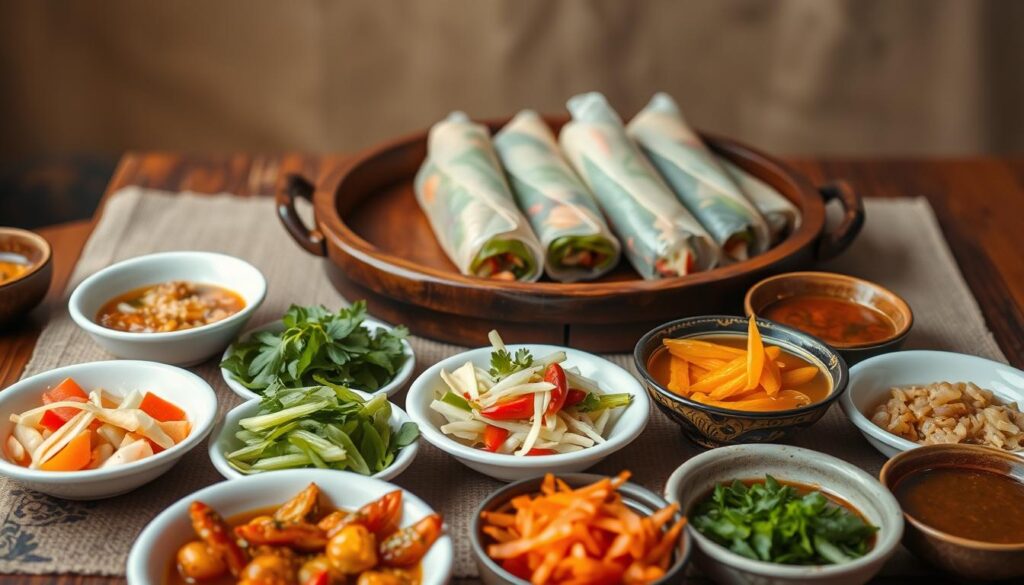
When exploring authentic vietnamese cuisine, the right side dishes can transform your Bo Luc Lac from a simple meat dish into a culinary experience. Regional vietnamese cooking emphasizes balance and complementary flavors that elevate the entire meal.
Fresh herbs play a crucial role in Vietnamese dining. Typical accompaniments include crisp lettuce leaves, fragrant cilantro, and mint. These herbs aren’t just garnishes – they’re integral to creating layers of flavor and texture that define traditional Vietnamese meals.
“In Vietnamese cuisine, side dishes are not an afterthought, but a carefully curated part of the dining experience.” – Vietnamese Culinary Expert
Rice remains the foundation of most Vietnamese meals. Steamed jasmine rice works perfectly with shaking beef, absorbing the rich marinade and providing a neutral base for the bold flavors. Some regions prefer broken rice, which offers a unique texture that complements the tender beef.
Pickled vegetables add a tangy contrast to the rich meat. Typical pickles include daikon radish and carrots, creating a refreshing counterpoint that cleanses the palate between bites. These traditional accompaniments reflect the deep culinary traditions of Vietnamese cooking.
By understanding these side dishes, you’ll transform your shaking beef into an authentic Vietnamese feast that celebrates the complexity of regional vietnamese cuisine.
Wine Pairing and Serving Suggestions
Elevating your authentic Vietnamese cuisine experience goes beyond perfect cooking techniques. The right wine pairing and presentation can transform your Bo Luc Lac into a truly memorable meal that celebrates Vietnamese culinary tradition.
Selecting the Perfect Wine
When choosing a wine for Vietnamese shaking beef, opt for medium-bodied red wines that complement the dish’s rich flavors. Pinot Noir stands out as an excellent choice, with its subtle fruitiness matching the beef’s robust marinade. Zinfandel offers another fantastic option, providing enough depth to stand up to the intense spices.
Presentation Artistry
Presentation matters in authentic Vietnamese cuisine. Serve your Bo Luc Lac on a white ceramic plate to highlight the vibrant colors of the beef and accompanying herbs. Arrange the meat slightly off-center, garnishing with fresh cilantro and thinly sliced red onions to create visual appeal.
Temperature and Serving Guidelines
Serve your shaking beef immediately after cooking to preserve its tender texture and optimal flavor. The ideal serving temperature is around 135-140°F, ensuring the meat remains juicy and succulent. Use warmed plates to maintain the dish’s temperature during serving.
“In Vietnamese culinary tradition, every detail matters – from preparation to presentation.” – Chef Mai Nguyen
Common Mistakes to Avoid When Cooking Vietnamese Beef
Crafting authentic vietnamese beef recipes requires precision and skill. Many home cooks stumble when preparing asian beef dishes, especially the delicate shaking beef. Understanding potential pitfalls can transform your culinary experience from mediocre to magnificent.
Temperature control stands as a critical factor in vietnamese beef recipes. Cooking at incorrect heat levels can quickly turn tender meat into a tough, unappetizing dish. Professional chefs recommend using high heat for a short duration to seal in flavors while maintaining the meat’s natural tenderness.
“Cooking is about passion, and passion can transform simple ingredients into extraordinary meals.” – Chef Martin Yan
Marination presents another potential challenge in asian beef dishes. Overmarinating can break down protein structures, resulting in mushy texture. Aim for 30 minutes to 2 hours maximum, ensuring your beef absorbs maximum flavor without compromising its structural integrity.
Common rookie mistakes include using incorrect meat cuts and neglecting proper resting time after cooking. Select high-quality beef sirloin or tenderloin, and always let your meat rest for 5-7 minutes after cooking to redistribute internal juices.
By avoiding these typical errors, you’ll elevate your vietnamese beef recipes from good to restaurant-quality, impressing family and friends with your culinary expertise.
Conclusion
Your culinary journey through authentic Vietnamese cuisine has unveiled the rich tradition behind Bo Luc Lac. Vietnamese shaking beef represents more than just a recipe—it’s a cultural experience that connects you with Vietnam’s vibrant culinary heritage. By mastering the techniques and understanding the nuanced flavors, you’ve learned to transform simple ingredients into an extraordinary dish.
The key to creating exceptional Vietnamese shaking beef lies in respecting traditional preparation methods. From selecting premium beef cuts to perfecting the shaking technique, each step contributes to a meal that tells a story. You now understand how marination, temperature control, and precise cooking techniques elevate this classic dish from ordinary to remarkable.
As you continue exploring authentic Vietnamese cuisine, remember that cooking is an art of passion and practice. Your newfound skills will allow you to recreate the flavors of Vietnam in your own kitchen. For more inspiring recipes and culinary adventures, visit luyarecipes.com and dive deeper into the world of Vietnamese gastronomy.
Embrace the spirit of Bo Luc Lac—a dish that represents the heart of Vietnamese cooking: simple ingredients, bold flavors, and a celebration of culinary tradition.
FAQ
What is Vietnamese Shaking Beef (Bo Luc Lac)?
Vietnamese Shaking Beef is an authentic Vietnamese dish featuring cubes of marinated beef stir-fried at high heat, characterized by a unique “shaking” technique that ensures even cooking and creates a delicious caramelized exterior. Traditionally made with high-quality beef cuts, the dish is known for its vibrant flavors of garlic, soy sauce, and often lemongrass.
What cut of beef is best for Bo Luc Lac?
For the most tender and flavorful Vietnamese Shaking Beef, use tenderloin or ribeye. These cuts have excellent marbling and tenderness that work perfectly for the quick, high-heat cooking method. Aim for cuts with good fat content to ensure juiciness and maximum flavor absorption during marination.
How long should I marinate the beef?
Ideally, marinate your beef for 30 minutes to 2 hours. This allows the meat to absorb the flavors of garlic, soy sauce, and other seasonings without breaking down the protein structure. Avoid marinating for too long, as the acid in the marinade can start to toughen the meat.
What is the signature “shaking” technique?
The shaking technique involves quickly moving the beef in a hot wok or skillet, creating a searing effect that caramelizes the exterior while keeping the inside tender. This method ensures even cooking and creates those characteristic slightly crispy edges that make Bo Luc Lac so delicious.
What are traditional side dishes for Vietnamese Shaking Beef?
Typically, Bo Luc Lac is served with steamed white rice, fresh salad greens, and a tangy dipping sauce. Some regional variations include pickled vegetables, fresh herbs like cilantro or mint, and a lime-pepper-salt dipping sauce that complements the rich beef flavors.
Can I make Vietnamese Shaking Beef if I don’t have a wok?
Absolutely! While a wok is traditional, you can successfully prepare Bo Luc Lac in a heavy-bottomed skillet or cast-iron pan. The key is to use high heat and work quickly to achieve that signature caramelized exterior and tender interior.
Is Vietnamese Shaking Beef spicy?
Traditional Bo Luc Lac is not typically very spicy. The dish focuses on a balance of savory, sweet, and umami flavors. However, you can add chili peppers or sriracha to the marinade or serve with a spicy dipping sauce if you prefer more heat.
How do I prevent the beef from becoming tough?
To keep your beef tender, follow these tips: use a high-quality cut, don’t overcook (cook quickly at high heat), slice against the grain, and avoid marinating too long. Cooking the beef for just 2-3 minutes total is usually sufficient to achieve the perfect texture.
